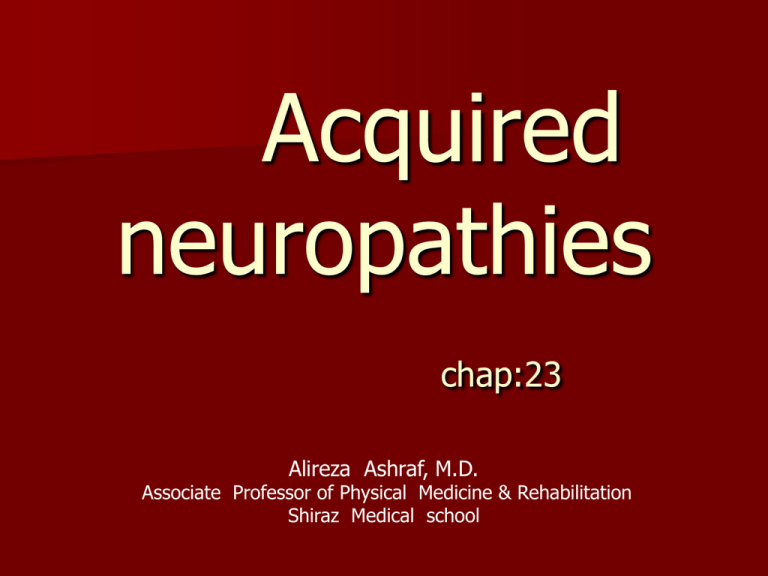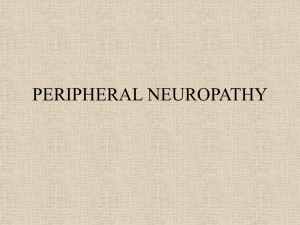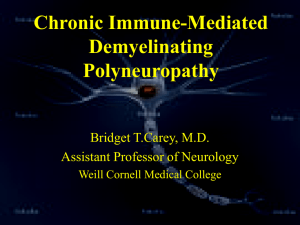
Acquired
neuropathies
chap:23
Alireza Ashraf, M.D.
Associate Professor of Physical Medicine & Rehabilitation
Shiraz Medical school
GBS
In one report earliest feature:
proximal nerve edema+ degeneration
myelin sheath within first week of illness
In other study prominent perivascular
inflammation in spinal root ,ganglia ,cranial
nerve and randomly along peripheral
nerve
Acute inflammatory demyelinating
polyradiculoneuropathy (AIDP)
Most common cause of acute generalized
weakness
Annual incidence:1-4/100000 general population
Slight male predominance
Peak age of onset in the 3-4 decade of life
60-70% of patient note some form of Acute
illness 1-3 wk before onset of neurologic
symptom (C.j 32%-CMV 13%-EBV 10%M.pnumonia 5%)
most patient initially note Tingling and numbness in
distal of lower limb and shortly thereafter in the distal
upper limb
Large fiber modality (vibration ,touch , position)
more severly affected than small fiber modality (pain
, temperature)
A few patient present only with sensory symptom
but EDX sign of motor involvement are typical
Major complaint of most patient : progressive
weakness
Mild facial weakness in 50%of patient during
course of illness.
Occasionally a descending presentation with
onset in the cranial nerve and progress to the
arm and leg
External urethral and anal sphincter usually
spared .although may be involved in severe
disease.
Autonomic instability is common in AIDP
Neonatal GBS : in infant of a mother with GBS due to Ab
crossing the placenta.
The disease usually progresses over the course of 2-4 wk.
Progression of symptom and sign for over 8 wk excludes
GBS and suggest the diagnosis of CIDP.
Respiratory failure in 30%
Neck flexion ,extension and shoulder abduction correlate well
with diaphragmatic strenght and thus important to follow
closely.
Most patients gradually recover satisfactory
function over several months
The mortality rate about 5%
Patient die result of RDS ,aspiration
Pneumonia ,pulmonary embolism ,arrhythmia
and sepsis
1.
2.
3.
4.
Risk factor for poor prognosis (slower
and incomplete recovery):
age greater than 50-60years,
abrupt onset of profound weakness,
need for mechanical ventilation,
distal CMAP Ampl less than 10-20% of
normal.
Lab feature
Elevated CSF protein accompanied by no or only a few
mononuclear cell is the characteristic laboratory findings and
evident in over 80% of patient after 2 wk.
In patient with CSF pleocytosis of more than 10
Lymphocytes (cell count >50), AIDP like neuropathies related
to lyme disease, recent HIV infection, sarcoidosis need to be
considered.
Elevated liver function test evident in many patient. In such
cases important to evaluate for viral hepatitis (A,B,C),EBV,
CMV
Antiganglioside Ab particularly anti GM1 correlates well
with c.j infection.
histopathology
The entire peripheral motor and sensory
nervous system including cranial nerve can be
involved from the most proximal aspect of the
ventral and dorsal root to the terminal region of
the intramuscular and sensory nerve fibers.
An initial preference for the nerve root
region ,areas where peripheral nerve commonly
entrapped and the motor nerve terminals.
Motor NCS
1.
2.
3.
4.
5.
Electrophysiologic hallmark of
demyelination:
prolonged distal latency
Slow NCV
Temporal dispersion
Conduction block
Prolonged F-wave latency
A hallmark is the asymmetric and multifocal
character of the EDX abnormality
Always perform F-wave study in both upper
and lower limb in patients suspected of
having
AIDP because of early predilection for the
proximal nerve segments and spinal roots.
In patient with rapid recovery ,particularly after PE or
IVIG the improved clinical status probably result
from coduction block resolution rather than
remyelination or regeneration of the axons.
Two important caveats about conduction block:
1. First, 5-7day after acute axonal loss, it is impossible
to distinguish between axonal loss and conduction
block
2. Second,in acute disease small reduction in CMAP
Ampl may be result from conduction block; however ,in
more chronic disease or later in acute disease alteration
in conduction velocity may result in pseudocoduction
block.
Examination of the pherenic and facial nerve
may be interest in AIDP.
Facial and supraorbital nerve evaluated with
direct facial nerve stimulation and blink reflex.
Maximum degree of motor conduction
abnormality occure within 3-8 wk.
Early abnormalities of distal CMAP Ampl and
latency and F-wave reflect the early
predilection for involvement of the proximal
spinal roots and distal motor nerve terminals in
AIDP.
There does not appear to be a correlation
between the nerve conduction velocity or
distal motor latency and clinical severity of
the neuropathy ,although distal CMAP
Ampl less than 10-20% normal are
associated with a poorer prognosis.
S-NCS
Upper limb SNAP particularly median nerve
affected more severly and earlier than sural
SNAPs.
Unlike most axonopathies , in which the
earliest and most severe abnormalities
involve the distal lower limb nerve (sural
SNAP), demyelinating disease are just as
likely to affect the median and ulnar SNAPs.
It can take 4-6wk for SNAP abnormalities to
peak.
The parameter most adversely affected is
SNAP Ampl.
Reduced SNAP Ampl can result from
secondary axonal degeneration ,conduction
block or phase cancelation.
With a pure sensory presentation , other
Disorders (acute sensory neuronopathy or
ganglionopathy) must be ruled out.
Needle EMG
EMG in patients with AIDP is primarily
adjunctive to explore the possibility of other
disease entities.
Earliest finding a reduced number of normalappearing MUAP firing at rapid rate.
Fib and psw may first be seen between wk 24,peaking at about 6-15wk;maximize earlier in
proximal muscle than in distal muscle.
Myokymia can be detected especially in facial
muscles.
Autonomic testing
Autonomic instability can be assessed by
measuring the EKG R-R interval
variation.
A alternative method is
SSR.
Plasma Exchange
reduced the time necessary to improve one
clinical grade, time to walk unaided, time on a
ventilator and percentage of patient improving
after 1-6 month.
Total amount of exchanged is 200-250ml/kg
over 10-14 day.
The removed plasma is replaced with
albumin.
IVIG
Replaced PE in many centers as the
treatment choice for AIDP because it is more
widely available and easer to use than PE.
Dose of IVIG is 2 gr/kg infused over 2-5 days.
Treatment should begin preferably within first 7-10
day of symptoms.
Improvement often not immediate .mean time to
improvement ranged from 6-27 day.
Unlike CIDP, corticosteroid do not appear
beneficial in the treatment of AIDP; in fact ,some
patient have done worse.
AIDP in children
The clinical , lab and EDX findings similar
to adult
75% have an antecedent infection
Major presenting complaint is pain
Most children with AIDP have a
satisfactory recovery , even those with
significant reduction in CMAP Ampl.
Acute motor-sensory axonal neuropathy (AMSAN)
Clinically and at least by initial EDX
,patient with AMSAN are indistinguishable
from AIDP.
Patient with AMSAN develop rapidly
progressive and severe generalized
weakness over only a few day as opposed
to a couple of wk in most patient with
AIDP.
Ophtalmoplegia and difficulty in swallowing may be
noted.
Muscle of facial expression are profoundly weak.
Most patient require ventilator support.
Sensation to all modality is reduced.
Complete areflexia is usually evident.
Prognosis of AMSAN much poorer than AIDP ;most
patient have a slow or incomplete recovery.
Some authorities suggest that C.j infection and
GM1 Ab are more commonly associated with axonal
form of GBS.
Histologic evaluation performed early in the
course of disorder is the only way to differentiate
axonal GBS from psudoaxonal GBS.
Markedly diminish Ampl or absent CMAP within 710 day of onset.
SNAP Ampl are profoundly reduced or absent.
Markedly abnormal reduction in recruitment .
Abundant fib and psw detected in most muscle
especially distal limb.
Acute motor axonal neuropathy (AMAN)
(chinese paralytic syndrome)
In northern china, AMAN is the most common
variant of GBS.
Serologic evidence of recent C.j infection
detected in 67- 92% of patient.
As in AMSAN , there is an abrupt onset of
generalized weakness.the distal muscle often are
affected more severly than proximal limb muscle.
Sensory sign and symptom are absent.
DTR may be normal or absent.
Patient generally make a good recovery within one years,
but residual distal limb weakness is common.
Mortality rate is less than 5%
The absence of prominent CSF pleocytosis
help distinguish AMAN from poliomyelitis,
which it can mimic.
The fact that many patient with AMAN
recover quickly suggests that low Ampl or
unobtainable distal CMAP are due not
necessarily to axonal degeneration but to
distal conduction block .
Characteristic NCS feature in AMAN is low
Ampl or unobtainable CMAP with normal
SNAP.
When CMAP are obtained, DML and
NCVare normal.
F-wave usually unobtainable but,when
present, show normal latency.
Other variant of GBS
1.
2.
3.
4.
Miller – fisher syndrome
Idiopathic cranial polyneuropathy
Pharyngeal-cervical-bracial weakness
Para paretic weakness
Miller – fisher syndrome
M/F=2/1 , mean age of onset in the early 40s.
An antecedent infection in 2/3 of cases.
Diplopia is the most common initial complaint.
Whether the ataxia is secondary to sensory
dysfunction or a cerebellar lesion is controversial. In
our experience , most patient have sensory ataxia.
Ptosis usually accompanies the ophtalmoparesis
,but pupillary involvement is uncommon.
Nearly 50% of patient describe paresthesia in face
and distal limbs.
Areflexia is evident in over 82%
anti GQ1b demonstrate in most patient.
Most prominent EDX abnormality in MFS is
reduced SNAP Ampl.
CMAP in the arm and legs are usually normal but,
mild to moderate reduction in facial CMAP
demonstrate in over 50% of patient.
Blink reflex may be abnormal.
There is generally no abnormal spontaneous
activity in limb or paraspinal muscles but , fib may be
detected in facial muscle.
Chronic inflammatory demyelinating polyneuropathy(CIDP)
An immune-mediated neuropathy
characterized by a relapsing or progressive
course.
Relapsing form=recurrent polyneuritis
Progressive form=progressive hypertrophic
neuritis or chronic GBS
Sign and symptom of neuropathy must be
progressive for at least 2 month, which
distinguishes CIDP from GBS or AIDP.
1.
2.
3.
4.
Four typical clinical course of progression
Chronic monophasic(15%)
Chronic relapsing(fluctuation of weakness or
improvement over week or months)34%
Stepwise progression 34%
Steady progression15%
Pattern of disease progression in CIDP
analogous to MS.
CIDP most commonly present in adult with a
peak incidence at about 40-60 years; slightly
increased prevalence in men.
Relapsing form has an earlier age of onset
,usually in twenties
Relapses have associated with pregnancy
Most patient present with relapsing or
progressive symmetric proximal and distal
weakness of the arms and legs.
Early in the course of illness ,only distal
weakness may be observed. however . If
weakness remain distal , other diagnoses
need to considered : hereditary demyelinating
neuropathy ,Para protein related neuropathy,
distal acquired demyelinating neuropathy.
Although most patient (80%)have both
motor and sensory involvement , a few
patient
may have pure motor (10%) or pure
sensory(5-10%)sign and symptom.
Sensory abnormality in 68-84%of patient ,
primarily affecting large fiber modality
(vibration ,touch)
Sensory ataxia, positive Romberg sign ,wide
base gait may be found.
Chronic sensory demyelinating neuropathy: only sensory
sign and symptom. however EDX reveal motor nerve
abnormality.
Most patient with a demyelinating neuropathy who have
mainly sensory sign and symptom with normal or only mild
distal weakness have an IgM monoclonal gammopathy .
Whenever a pure sensory neuropathy is present ,
consideration should be given to other diseases well, such as
sjogren syndrome or paraneoplastic neuronopathy, both
associated with sensory ganglionitis.
Most patient have areflexia or hyporeflexia.
Some patient develop dropped head syndrom secondary
to neck extensor weakness.
Autonomic dysfunction (incontinency , impotency) less
common.
Respiratory insufficiency reported in 8-15 % of patient.
3-5% of patient have evidence of CNS demyelination clinically .
Patient may developed a myelopathy due to compression of spinal
cord by hypertrophied nerve roots.
1.
2.
3.
4.
5.
6.
7.
8.
9.
10.
CIDP like neuropathy :
HIV infection
Hepatitis
Inflammatory bowel disease
DM
SLE
Monoclonal gamopathy of uncertain significance (MGUS)
Lymphoma
Bone marrow and solid organ transplantation
Paraneuoplastic complication of pancreas and colon
carcinoma, SCC lung , melanoma, cholangiocarsinoma
Toxic induced neuropathy (procainamide, cyclosporine
and tacrolimus)
LAB feature
An elevated CSF protein is found in 80-95% of patient.
Cell count is usually normal
.
WBC CSF should be <10/mm3
Elevated CSF cell count should lead to consideration of
HIV infection, lyme, leukemic infiltration of nerve root
Oligoclonal band demonstrated in the CSF in 65%
MRI with gad may reveal hypertrophy and enhancement of
the nerve root and peripheral nerve.
M-NCV
CMAP parameter most useful diagnostic
test in demyelinating process.
a 50% drop in Ampl or negative peak area
for define conduction block.
Increased CMAP Ampl , Increased NCV,
decreased conduction block, seen in
association with improvement in strength.
Clinical improvement primarily result of
resolving conduction block.
S-NCV
>80% low Ampl or unobtainable SNAP.
A characteristic finding is abnormal median
or ulnar SNAP when the sural SNAP are
normal.
A similar discrepancy between the upper
and lower limb SNAP seen in sensory
ganglinopathy , but the EDX abnormality in
such cases are axonal , not demyelinating.
EMG
Widespread fib and PSW are commonly
detected in intrinsic foot and hand muscle
and more proximal muscle.
The degree of fib and PSW is high during
an exacerbation with a reduction during
clinical remission.
treatment
Treatment of choice depend on other medical
problem(avoid IVIG in renal defficiency) and accessibility.
Corticosteroid: prednisone 1/5mg/kg per day for 24wk,then switch to alternate-day.
Functional muscle recovery is first noted in the
proximal limb muscle.
PE: unfortunately response to PE is transient, usually
lasting only a few wk.
PE used usually in combination with prednisone, in patient
with severe generalized weakness.
PE used alone in patient in whom we wish to avoid long
term prednisone(poorly controled DM or HIV infection) or in
whom IVIG is contraindicated (renal insufficiency).
Used a trial course of PE in patient who do not fulfill all of
criteria for CIDP or those that have an underlying condition
making the diagnosis difficult(DM and superimposed CIDPlike neuropathy).
IVIG: for many authorities , IVIG has become
the treatment of choice in CIDP.
A IgA level should be assayed before
administering IVIG.patient who are IgA
deficiency due to IgE anti IgA antibody or a
congenital deficiency may develop anaphylactic
reaction to IVIG.
Azathioprine
Cyclophosphamide
Cyclosporine: decreased relapse rate in
patient with the relapsing form of CIDP
and improved strength and function in
those with the chronic progressive form.
Interferon
prognosis
Require symmetric,proximal and distal arm and leg
weakness to diagnose CIDP.
Patient with mainly sensory symptom, mild distal weakness
or asymmetric motor involvement much less responsive to
specific form of therapy
Poor long term prognosis: progressive course, CNS
involvement and particularly axonal loss.
CIDP in children
Commonly present with difficulty in ambulating
Response to standard form of therapy
CIDP may be confused with a hereditary neuropathy (CMT)
Family history
EDX :CMT associated with symmetric and diffuse
involvement of peripheral neuropathy.
Thus temporal dispersion and conduction block are not seen. there is
usually uniform slowing of conduction velocity as well as symmetric
involvement of proximal and distal segment.
In contrast , the multifocal nature of CIDP result in nonuniform slowing of
conduction velocity, temporal dispersion and conduction block.
Para protein – related neuropathies
(monoclonal gammopathy) and CIDP
Although IgG is the most common paraprotein in the general
population ,IgM is by far the most common monoclonal protein in
patient with peripheral neuropathy.
IgM-MGUS neuropathy are typically demyelinating but can be axonal.
Demyelinating and axonal neuropathy seem to occure similar frequency
in IgG and IgA-MGUS
The IgM neuropathy seem to be less responsive to immonotheraphy
than IgG and IgA neuropathy.
At least 50% of IgM group have antibody against myelin – associated
glycoprotein.
Most patient present with a late onset distal and
symmetric sensorimotor neuropathy.
Sensory ataxia and tremor were common.
IgM neuropathy experience more disability related
to sensory loss. weakness was only a minor feature.
In IgM neurapathy ,NCV more slowing and
prolongation of distal latency compared with IgG and
IgA.
Patient with MGUS-CIDP had a more indolent
course , more frequent sensory disturbance with
ataxia and less severe weakness than patient with
idiopathic CIDP.
no difference in various motor parameters.
MGUS group had more severe sensory conduction
abnormality.
Ig-M subgroup: smaller TLI.
Idiopathic CIDP had a significant improvement
rate(88%) than MGUS CIDP(50%)
Distal acquired demyelinating symmetric
neuropathy (DADS)
Monoclonal protein detected in 75% cases
(IgM)]
No significant EDX difference between IgM-DADS,
idiopathic DADS or CIDP.
Patient with IgM-DADS neuropathy demonstrated a
poor response to immunotherapy , whereas patient
with idiopathic DADS and CIDP usually improved with
therapy.
Multifocal motor neuropathy (MMN) (multifocal
demyelinating neuropathy with conduction block)
An immune mediate demyelinating
neuropathy characterized clinically by
asymmetric weakness and atrophy, typically in
the distribution of individual peripheral nerve.
MMN is commonly misdiagnosed as ALS;
however muscle involvement is in the
distribution of individual peripheral nerves, not
spinal roots.
Incidence of MMN much less than ALS(1/50)
M/F=3/1
Age at onset of symptom usually early in fifth decade of life.
Typically, diagnosis is delayed by several years because of
the slow ,insidious progression and misdiagnosis of the
disorder.
Patient develop focal muscle weakness accompanied by
cramps and fasciculation, usually beginning in the distal
Upper limbs.
Patient generally present with intrinsic hand
weakness ,wrist drop or foot drop.
Mild sensory symptom have been described
,but if there is objective sensory loss, one
should consider MADSAM neuropathy.
P/E reveals weakness in a multifocal pattern in the upper and
lower limbs, paralleling a peripheral nerve as opposed to the
spinal segmental/root distribution seen in motor neuron
disease.
A helpful feature is the lack of atrophy in weak muscle group
early in the course of illness; however decreased muscle bulk
can result in time from secondary axonal degeneration.
Sensory exam should be normal.
MSR variable in unaffected limb, whereas depress or absent
in weak muscle.
The observation of fasciculation, weakness and
essentially preserved sensation is certainly
suspicious for an anterior horn cell disorder.
however ,the multifocal peripheral nerve
involvement ,as opposed to spinal root level of
dysfunction, combined with sparing of muscle bulk
point to diagnosis of MMN.
In contrast to CIDP and MADSAM,CSF protein is
usually normal in patients with MMN.
Twenty to 80% of MMN have detectable IgM
antibody direct against gangliosides ,mainly GM1but
also GM2.
A high titers the antibodies appear to be rather
specific for MMN ,but the sensitivity of the test
is too low.
The most sensitive and specific test is the NCS.
EDX
There is often evidence of conduction block in multiple
upper and lower limb nerves.
conduction block is not located at the expected common
nerve entrapment sites, but in the mid-forearm or leg,
upper arm, across brachial plexus, or nerve root region.
conduction block may be present not only in multiple
different nerves but also at several location along the course
of the same nerve.
A reduction in distal CMAP AMPL can be seen in chronic
lesions due to secondary axonal loss.
Although motor conduction block has been
considered the EDX hallmark of MMN, other
features of demyelination:
(prolonged distal latency, temporal dispersion ,slow
conduction velocity and prolonged or absent Fwaves) are typically present on motor NCS.
Diagnosis does not require conduction block if
other features of demyelination are present.
SNAP parameters is normal.
Needle EMG
Unaffected muscles should demonstrate
no abnormalities.
In weak muscle: reduced recruitment , fib
and PSW, fasciculation potential and rarely
myokymic discharge.
These abnormalities improve after treatment.
Treatment
In contrast to CIDP and MADSAM neuropathy ,few
patients(<3%)With MMN improve with high doses of
corticosteroids or PE.
Intravenous cyclophosphamide was the first
immunosuppressive agent demonstrated to be
effective in MMN ,over 70% of reported patients
improved clinically after treatment.
IVIG is now the treatment of choice in MMN.
Not all patients with MMN respond to IVIG. some series
have noted that later age of onset and patient who have
significant muscle atrophy do not respond as well to
treatment.
Multifocal acquired demyelinating sensory and motor
neuropathy (MADSAM)
The sign and symptom of MADSAM neuropathy are essentially those of
mononeuropathy multiplex.
M/F=2/1
Mean age of onset in the early 50s.
Onset is usually insidious and slowly progressive with initial
involvement usually in the upper limb.
Motor and sensory involvement to peripheral nerve distribution rather
than generalized stocking and glove pattern.
MSR is decreased or absent in a multifocal , asymmetric distribution.
CSF protein elevated in 60-80% of patient.
As with CIDP and MMN ,NCS demonstrate conduction
block, temporal dispersion, prolonged distal latency and Fwave and slow NCV in one or more motor nerves.
SNAP are absent or small AMPL.
Fib ,PSW and polyphasic ,long duration MUAP.
In contrast to MMN but similar to CIDP , most patient with
MADSAM improvement with steroid.
Most patient improve with IVIG.
Idiopathic sensory neuronopathy / ganglionopathy
Believed to be caused by an autoimmune
attack directed against the dorsal root ganglia.
DDX of sensory neuronopathy includes:
1.
paraneoplastic syndrome, which is typically associated
with anti-HU antibody
Sjogrens syndrome
Medication or toxins
Infection agents
2.
3.
4.
A slight female predominance,mean age of onset is 49 Years
The neuronopathy can present acutely with an abrupt onset over a few
hours or developed more insidiously
Numbness can begin in face , trunk or limbs.
Symptoms begin asymmetrically and in the upper limb in nearly onehalf of patients.
Usually the sensory symptoms are generalized, but they can remain
asymmetric.
Because of the prominent large fiber sensory loss, patient describe
clumsiness of the hands and gait instability.
Marked reduction in vibration and position sense.
The deficit more impaired in upper limb than lower
limbs, unlike length-dependent axonal neuropathy.
Pain and temperature are less affected.
Manual muscle testing usually normal.
Patient often complain of weakness.
Sensory ataxia resulting from the loss of
proprioception
Positive Romberg sign
MSR are decreased or absent.
Idiopathic sensory neuronopathy is a
diagnosis of exclusion
MRI reveal gadolinium enhancement of the
posterior spinal roots, increased signal
abnormality on T2 image in the posterior
columns.
Most prominent EDX abnormality is absent or low AMPL
SNAP.
Sensory distal latency and NCV normal or mildly abnormal.
DML and MNCV and F-waves usually normal.
H-reflex and Blink reflex typically absent.
An abnormal Blink reflex favors a nonparaneuoplastic
etiology for sensory neuronopathy but does not exclude an
underlying malignancy.
Needle EMG is usually normal.
treatment
PE,IVIG and corticosteroid
A few patient may improved spontaneously.
There is no indication to treat a patient
with a stable deficit
Idiopathic autonomic neuropathy
The most common symptom was orthostatic dizziness or
lightheadedness(80%)
GI involvement is the second most common symptom(70%)(neusea,
vomiting diarrhea , constipation and ileus)
Thermoregulatory impairment with heat intolerance and sweating was
present in most patient.
Blurred vision, dry eye and mouth, urinary retention and incontinence
and impotence are often present.
Muscle strength was normal.
QSART (quantitative sudomotor axon reflex test) score are
abnormal in 85% of patient.
Abnormal thermoregulatory sweat test in 12-97%
Motor NCS are normal.
SNCS have normal in most patient. a few patient
demonstrate reduced SNAP AMPL or slight prolonged
latency
SSR response may be absent.
PE,IVIG and prednisone tried with variable
success.
Most important aspect of management is
supportive therapy for orthostatic hypotension,
bowel and bladder symptoms.











